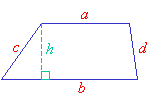

Geometry: Perimeter of Polygons
More Lessons on Geometry
In these lessons, we will learn the perimeter of the following polygons:
- square
- rectangle
- parallelogram
- triangle
- rhombus
- trapezoid
Perimeter of Polygons
The perimeter of a polygon is the sum of the lengths of its sides. It is the distance around the outside of the polygon.
See also area of circles, circumference of circles.
Perimeter of a Square
Since the sides of a square are equal, the perimeter of a square is 4 times the length of its side.
Perimeter of a square = s + s + s + s = 4s
where s is the length of one side
Perimeter of a Rectangle
A rectangle has four sides, with opposite sides being equal in length.
Perimeter of a rectangle = l + l + w + w = 2(l + w),
where l is the length and w is the width of the rectangle.
Worksheet 1, Worksheet 2, Worksheet 3 to calculate the area and perimeter of rectangles.
Perimeter of a Parallelogram
Similar to a rectangle, a parallelogram has four sides with opposite sides being equal in length.
Perimeter of a parallelogram = l + l + w + w = 2(l + w)
where l is the length and w is the width of the parallelogram.
Worksheet to calculate the area and perimeter of parallelograms
Perimeter of a Triangle
Perimeter of a triangle = a + b + c
where a, b and c are the lengths of each side of the triangle.
Perimeter of a Rhombus
A rhombus has 4 equal sides, so the perimeter of a rhombus is 4 times the length of its side.
Perimeter of a rhombus = s + s + s + s = 4s
where s is the length of one side
Perimeter of a Trapezoid

a is parallel to b
Perimeter of a trapezoid = a + b + c + d
where a, b, c and d are the lengths of each side.
Videos
How to find the Perimeter of a Rectangle? How to find the Perimeter of a Parallelogram? How to find the Perimeter of a Trapezoid? How to find the perimeters of rectangles, squares, triangles and other polygons?Word Problems involving perimeter of polygons
Example:A rectangle is three times as long as it is wide. If the perimeter is 62 cm, what is the length?
The width of a rectangle is 6 cm less than the length. If the perimeter is 52 cm, what is the width? Example:
The length of a rectangle is 7 cm more than 4 times its width. It perimeter is 124 cm. Find its dimensions. Example:
The width of a rectangle is 4 ft smaller than 3 times its length. Its perimeter is 144 ft. Find its dimensions.
Example:
A rectangle garden is 2.5 times as long as it is wide. It has a perimeter of 1.6 feet. How long and wide is the garden? Example:
The perimeter of a triangle is 26 cm. The first side is 6 cm shorter than the second side. The third side is 2 cm shorter than twice the length of the first side. What is the length of each side?
Try out our new and fun Fraction Concoction Game.
Add and subtract fractions to make exciting fraction concoctions following a recipe. There are four levels of difficulty: Easy, medium, hard and insane. Practice the basics of fraction addition and subtraction or challenge yourself with the insane level.



We welcome your feedback, comments and questions about this site or page. Please submit your feedback or enquiries via our Feedback page.





